

Brandi Ransom - NanoJapan 2015
Rice University
Major: Materials Science & Nano Engineering
Class Standing: Freshman
Anticipated Graduation: May 2019
NanoJapan Research Lab: Prof. Shigeo Maruyama, University of Tokyo
NanoJapan Research Project: Transferring Carbon Nanotubes and Graphene onto Antireflective Surfaces for High-efficiency Solar Cells ![]()
1st Annual Smalley-Curl Institute Summer Research Colloquium Undergraduate Poster Prize: Third Place
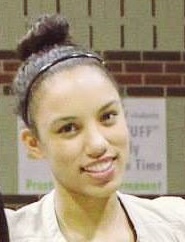
Why NanoJapan?
NanoJapan is foremost an opportunity. It is a chance to test if we truly wish to become as invested in this field as we think we are. The program allows us to realize our passions so early on in our academic careers. We will be tested in a real life situation, exploring specific parts of a field that may usually not be available to us. Research isn’t about the glory, it is about the work. This program is long enough to push us to realize the full circle of research. The collaboration and ethics that are always spoken about in engineering lectures will be put into practice. This program will let us see how prepared we are for the real world, working in an international lab. So many times is diversity stressed in school, and now we get to see the application. We have a lot to learn, and this program will push us to improve academically as well as help us decide on our futures.
This program brings our classroom education into the real world, testing our skills in practice, and not just on paper. And because we are in a real lab, there is even more reward than a numerical grade. NanoJapan is a program that will teach us more about how to react and interact than to memorize. I believe this experience will make us grow up. We will also have to interact within a completely different culture, which should make us more aware of how we are as human beings. Hopefully we will not put on a show for Japan, but improve as people as we understand a new culture. I am looking forward to the social aspects in Japan. How labmates versus friends talk to each other, where and when people go out for fun, and how respect is used in different relationships. Of course, I am also going to learn an incredible amount of technical tools from my lab. I can’t wait to come back with a different academic and social perspective on the world.
My goals for this summer are to:
Meaning of NanoJapan
NanoJapan is an opportunity that will give you the opportunity to become a semi-real person for the summer. You will be involved in things that most people will never come close to touching, and you have the freedom to take things as you will.
Research Project Overview
Transferring Carbon Nanotubes and Graphene onto Antireflective Surfaces for High-efficiency Solar Cells ![]() 1st Annual Smalley-Curl Institute Summer Research Colloquium Undergraduate Poster Prize: Third Place
1st Annual Smalley-Curl Institute Summer Research Colloquium Undergraduate Poster Prize: Third Place
My research was 95% preparation as making solar cells can take a very long time. I spent about 87% of my time at work in the lab. The work is very stress full for the fact that communicating in a place with such silent-but-strict culture can be confusing. My hours were “flexible” and lab mates were willing to help, but most of my days were spent working by myself. We had weekly lab meetings which were held mostly in Japanese that let the sensei’s catch up with the work you were doing. My mentor was my main point of contact for everything in the lab, but there were still opportunities for me to visit with other students from across the campus.
I came in knowing that I wanted to do synthesis, which related to my project in the way that I was able to work with acid and watch things bubble. On the science side of this project, I learned that I do like the synthesis part of materials science, and I actually enjoy it more than the bioprocess subjects I was exploring. It is very difficult for me to say that this experience affected me in anyway as far as exploring my future career options. The experience seems so different from anything that I would have in America that I don’t want to judge any of my future experiences in America based on my Japanese experience. I am able to say that I could possibly see research in my future, although I’m not sure for what length of time I would be able to handle it.
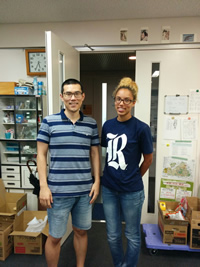
The lab had a nice working environment. Everyone kept to themselves and their project most of the time and there was a steady flow of movement with people going between the office and the lab. My lab mates were very approachable if I ever needed to borrow the equipment or needed help with a part of my project. Although I wasn’t part of the social life in my lab, many of the other students would play basketball together or have dinner after they finished work. Kehang, my mentor, was absolutely fantastic. He really let me learn on my own and gave me direction only as far as things that 100% had to be done either for sensei or because we didn’t have the lab equipment. He gave great discussion as far as scientific feedback for the parts of the experiment that I was not familiar with. Our string of emails can attest to his awesome ability to answer questions. Besides Kehang, there were a few students as well as another faculty member (Shimata-san) who were great to me. We were able to become closer and it was nice to have people to talk to outside of a scientific setting. I enjoyed my time working in the Maruyama Lab and am grateful for everything I learned both scientifically and personally.
Daily Life in Japan
My routines could be divided into weeks and weekend. Every weekday I would wake up around 8, make breakfast, walk 40 minutes to work, work for a fairly long time, walk back home and fall asleep. I usually cooked all three meals by self, so lunches were eaten at my desk, but dinners were made and eaten at home with my house mates which was really fun. They gave me tips on how to cook Japanese food and let me try their soup. If I was lucky I would be able to see one of my new friends for dinner. Weekends were great because I was able to see other NanoJapaners. We did all of the touristy and non-touristy things together, including going out to different cities, getting lost, and meeting up with Japanese students. I was actually able to live as a real adult for the summer, which gave me a new respect for people who decide to leave the college bubble. Some days I did do things on my own such as find an improv comedy class and play Frisbee. One of our group’s favorite activities was to try any bakery that we found, the best one is actually right next the University of Tokyo so I was very lucky. You really get to do what you want because you are completely on your own. I had fun just eating at local shops or getting my hair done, things that seem mundane in America are so much more interesting in a foreign country. I actually appreciated the slight struggle with the language barrier, because people are still willing to help, and you form a connection with everyone you meet.
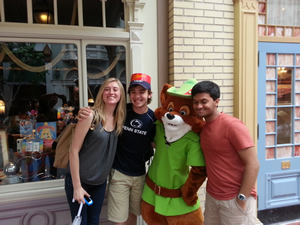
Complete the following sentences
My favorite experience in Japan was .... ordering blindly.
Before I left for Japan I wish I had ... been prepared for an earthquake.
While I was in Japan I wish I ... had more free time.
I actually expected more from Tokyo. In movies it is always portrayed as this bustling city with a lot of light and new fashion and new technology. I expected neon lights and different hair colors and the Iphone 34. I thought that every building would be made of stainless steel and glass and the city transportation was solely bullet trains. I expected Japan to be different from America in that it would be 15 years ahead, but instead it’s just different.
There are tall buildings, but they average to be only about 8 stories tall. The buildings are also made out of brick or concrete, so everything looks less sleek than I thought. Most people here have the same hair cut, and it is black in color. In fashion, it is a more stylish place than the US (jeans are below the casual line here), but they don’t wear many bright colors. Everyday people wear all kinds of neutrals and white and black. The city isn’t so much bustling as it is organized. Everyone here follows the rules, all of the time. It is because of the “wa” or harmony of Japan. Everyone works hard to make sure they can keep flowing in daily life. In this harmony there is a mindset that is more tuned to respecting others here, so it is a very quiet city. No one speaks casually in public places because they wouldn’t want to disturb others. And many people will not say how they really feel because it may have offend someone in the slightest way. To me it seems a little sad, because it is a very impersonal environment.
On the bright side. I could not have asked for a more efficient city. The subway comes every 5 minutes, on the dot. People always walk on the right side of the walkway and cars don’t run red lights. The city is safe so we can go and enjoy late meals. Everyone here is nice and can help us through our severely broken Japanese. No one is late to anything, ever. People aren’t being obnoxious in anyway. Everyone moves with a purpose, so there aren’t any clogs on the walkway. The Japanese are so proud of being Japanese that they are willing to show us the coolest places around town. Because everyone keeps to themselves I don’t have to worry about trying come up with elevator conversations every time I meet someone new. The cars are much nicer here; we pass by a Maserati, BMW, and Ferrari shops on our way to school every day. Everything in this country seems to run smoothly.
Language classes are a fun time! It’s just a lot of memorization mostly. Because we don’t have a long time to learn the language, we are learning the most useful phrases and vocabulary. Learning Katakana is very helpful because when we read Katakana on street signs, the word sometimes translates to an English word. The most difficult part for me is learning the particles that go with each different part of the sentence (ex: verb, noun, direct object, place, time). We are also moving at an extremely fast pace through the material. Even with the homework, I wish we had more practice. Talking to the KIP students is extremely helpful in this regard, but I still get many confused stares whenever I attempt a question for the first time in Japanese. I try to put myself in situations where I can practice the Japanese. Such as when I get lost jogging around Tokyo and then have to ask for directions, it’s really just so I can practice the language.
Overall my first week in Japan has been amazing. I’ve learned a lot of useful Japanese, know where to eat, and can navigate the subway system. I feel like I’m learning a lot about the culture even though I don’t quite fit in just yet. We have gotten to see many things native to Japan and are slowly exploring the rest by ourselves. I don’t believe I have offended anyone horribly yet (knock on wood). The weather has been great and Packard-sensei is making sure that we are staying on schedule and having fun. Everyone in Japan has been extremely welcoming and I can’t wait to continue this experience.
Question of the Week
A question I do have is: “how do all of the Japanese stay in such good shape?” There is not an abundance of fruits and vegetables here, so it seems as if there food is less nutritious, and there are no fields anywhere for people to play sports. America could use a tip or two from the Japanese in the health department.
Intro to Nanoscience Seminar
I have to admit that I don’t have a huge background in nanotechnology. Although I have had basic physics, I am having trouble grasping many of the concepts that we review in class. However I understood more in the second lecture than I did in the first lecture, which means I’m learning, and that keeps me excited for future lectures.
So far we have talked about a few theorems and concepts important to spectroscopy specifically. I learned about the “gap” in electronic bands for semi-conductors and how important they are. The photoelectric and photovoltaic effect were great examples of this electron movement. I have now learned about how a Fempto-second laser actually works, and why Terahertz is so important. Terahertz is a fairly unexplored frequency section compared to other frequencies, so I am excited for everyone’s projects this summer. We learned about what went on inside the semi-conductors during Fempto-second spectroscopy, but I would be interested to know more about the different possible materials and their specific properties.
Initial Research Project Overview
My project has been described to me as the “growth of high-quality graphene and application to graphene-silicon solar cells”. One of the main processes in the growth of graphene is Chemical Vapor Depostion (CVD), which I am lucky enough to have experienced at Rice this past year. Through the papers I have read, we can add to the efficiency of the graphene by doping the solar cells. Different doping materials have effects of charge separation and collection which leads the better energy transfers. We can also coat the cells in an antireflection colloid to improve the efficiency. This coating affects the current density. I believe that I will be working with these two techniques over the summer in trying to make a more efficient solar cell.
Nagano was amazing! It will definitely be a highlight of my NanoJapan experience. We were able to ride the bullet train there, which was really nice. It may be the smoothest form of transportation I have experienced. And then we arrived and it was like walking into a postcard. We were surrounded by mountains and you could see rice fields across the lands in between houses.
After a quick lunch, our first Nagano venture was planting rice. We were served a snack of rice paddy and pickled apricot and salad and tea by the sweetest family I have ever met. They led us to the rice field, which looks like a square pond, and we were able to squish around in the mud and plant some rice. Then they also had some animals we were able to feed; it took a little time for the goats to warm up to us and the horse kept getting confused on why we were feeding the sheep and stole its bread, so it was very entertaining. We then took a bus ride into the mountains, some of the roads were near vertical, and walked to see a cat shrine. Then we were able to check in to our Hotel, which was a Japanese Inn. There could not have been a better place to stay. It made the Japanese experience very real instead of simply a tourist excursion. We had a 16 course meal at the Hotel which might have been the most exquisite well rounded meal I have eaten in my entire life. We all learned how to ask the question, “What is this?” by the end of the meal.
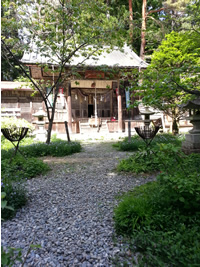
Cat Shrine!
The next morning I woke up as refreshed as a recently watered orchid. We visited a Shinshu University in Nagano and had a discussion with some of the students. We were then taken to some of the beautiful spots around town, which was basically everywhere. Then we had locals come and speak to us about their agriculture and culture where I learned about a new vegetable (that I currently can’t remember). We also had a barbecue with some locals where we got to eat mushrooms that looked like pine cones as well as got to participate in an actual fire dance!! It was a great day summed up by a multi-hour Onsen bath. We figured out that the Onsen has the ability to make everyone share their secrets, which was pretty nice after only 1 week of knowing each other.
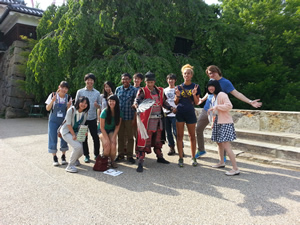
Hanging out outside a castle with the Ueda HS students!
On our final day we went to make Soba Noodles! Luckily they also brought us real Soba noodles after we finished eating ours, because although we were basically professionals after a 5 minute tutorial, even professionals make mistakes. We were then able to spend the day with high schoolers from the area! They took us to a castle where samurais used to fight and an ice cream shop that only sold tea flavored Ice cream (Even though it tastes like there is no sugar in the ice cream, and it actually tastes like tea). It was a great way to end the Nagano trip. 10 out of 10 stars; I would recommend this trip to everyone.
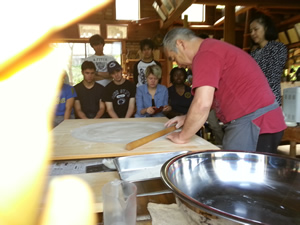
A professional Soba Maker
The hospitality here was fantastic. Contrary to the United States where we find hospitality in conversation, in Japan you can see it in the attention to detail. In our hotel, the water in the kettle was already warmed when we arrived, and the presentation of even our snack when we planted rice was fantastic. Everything that you would think would be casual is thought through, nothing is materialistic; they emphasize the quality of their actions. And also, everyone was happy to share about their culture. They were very proud of what they did (as they should be, because it was perfection) and how they did it. The locals introduced us to some new rice-based granola they were bringing to market and you could just see how the entire town was working together to make their town the best it could be. It was a very genial atmosphere.
I was not expecting everyone to be so open with their life stories, which was a very pleasant surprise. While I’ve been in Japan I have heard the phrase, “if you are proud of something, don’t show it off.” So it was great to be welcomed into their tight-knit community. The students at the university were very open about their university classroom experience, where you could see that there is a lot of pressure to be correct in schools, as some of the students said they were afraid to ask questions. This was not much of a surprise after spending time with the KIP students. Throughout the entire experience, you definitely feel the Japanese value that they were all very proud of being Japanese. I think it made our trip much more memorable.
This trip definitely let me see how deeply rooted the Japanese tie themselves to nature and history. I think it will be easier for me to understand the reasoning and explanations behind the behaviors in this country. I feel like the rest of the trip I will be able to explain American culture in these terms and connect more to the Japanese people.
Intro to Nanoscience Seminar
The lecture from Tonouchi-sensei became very technical very quickly. What I found most helpful was when we went through a diagram of a Fempto-second laser. It brought a very discrete application to the topics that Dr. Stanton reviewed in the week prior. The laser can be used for evaluation of different properties. He also showed us how many properties are correlated in various equations, so a lot of information can be gauged in a very short time span.
Kono-sensei followed with a lecture that was very helpful to our group. He described the mechanisms of different materials to work within electronics because of their “band gaps”, the area between the conductive and valence bands. Normal semiconductors have dynamic properties within their bands (intra band), where absorption depends on frequency, as well as between bands (inter band), where absorption is independent of frequency. He went into the details of properties in carbon nanotubes and graphene. Graphene has intra band and inter band dynamics occurring simultaneously because graphene doesn’t have a band gap. These properties deal with electron dynamics, especially how electrons scatter. In my lab I will be researching ways to improve the properties of graphene so that I can lengthen the scattering time to promote absorption. He then spoke about how single layer Molybdenum Disulfide (MoS2) is a great material in TeraHertz technology because of its direct band gap. In my research lab at Rice I have been growing MoS2 for the past year so it was great to see the molecular science as well applications of the material. I do have to admit that actually having an idea of what Kono-sensei was speaking about for a full 2 minutes made me feel the smartest I have so far in this program. After this lecture I was definitely more ready to take on the research project this summer.
In Dr. Kono’s following lecture he spoke even more over graphene (bonus!). He focused on the relationship between electrons and photons in the material and how it is applied in conductivity of the material. He provided an example of how we can combine properties to find out even more about the material. We use the Hall Effect, which measures the voltage perpendicular to both the current and magnetic field, to measure the density of electrons. And after finding the conductivity of graphene, which came across as a fairly basic procedure, we are able to find the mobility of electrons, which is very important when looking at absorption and scattering. Rocco, a fellow NanoJapan-er, was able to deduce that we have to use a different relativistic equation for the energy of electrons within graphene. This is different than the usual relativistic equation used in most other materials, because of the different interactions of electrons because of graphene’s lack of a band gap. Moral of the story was, that electrons in graphene behave like photons. Because of this we want to dope graphene with other materials to raise its top energy level. Doing so will add properties to the physical structure of graphene that makes it attractive so that it becomes better suited for electronics. This week was great because a great portion of topics was directly applicable to my research.
Besides the fact that we spent almost the entire time speaking about electron properties, something that caught my interest was in Tonouchi’s overview of Terahertz applications. He mentioned how the imaging applications could be applied to the medical industry (specifically polymorphs in medicines). It was mentioned for only a sentence, but Terahertz application to pharmaceuticals is what initially interested me in the NanoJapan program so I would be interested in any further information on this topic.
Preparation for Research Internship - Article Review
As I mentioned doping in an earlier paragraph, I can also highlight an article I read for my lab this week. This paper focused specifically on graphene-based Schottky junction solar cells. On various substrates the power conversion efficiencies (PCE) can be increased from .1-2.86% to 8.6% with chemical charge transfer doping of bis(trifluoromethanesulfonyl)-amide (TFSA).
Miao, Xiaochang, Sefaattin Tongay, Maureen K. Petterson, Kara Berke, Andrew G. Rinzler, Bill R.
Appleton, and Arthur F. Hebard. "High Efficiency Graphene Solar Cells by Chemical
Doping." Nano Letters 12 (2012): 2745-750. DOI: 10.1021/nl204414u
The properties in graphene are said to be tune-able to maximize solar cell efficiency, and from this doping they were able to deduce that this technique will work on other semiconductors as well. The specific improvements in the PCE are due to an increase in the Schottky barrier height (SBH), the difference between the interfacial conduction band and Fermi level (basically an increase in potential (V)), and less resistive losses because the doping makes the graphene have a higher conductivity.
The graphene was grown by chemical vapor depositions. Silicon/Silicon Oxide wafers were prepared with an Au/Cr layer and a buffered oxide etch. By exposing the silicon in the wafer, and giving the graphene a contact layer, it has proved to improve device performance. The graphene was transferred to the wafer which was soaked in an acetone bath for twelve hours. The graphene was then doped with TFSA by means of spin casting. First the external quantum efficiency (EQE) was measured by illuminating the devices with monochromatic light and measuring the voltage signals with an oscilloscope. Electrons are transferred from the Si to the graphene causing the Schottky junction. Then photons may be absorbed and cause electron-hole pairs in the silicon from which graphene can collect the charges and power can be generated from the device. For p-doping of graphene sheets alone, the PCE is increased to 1.9% and for graphene/n-silicon cells, the PCE increased to 8.6%.
The article goes on to explain the process through equations. The Schottky barrier height is related to the difference between the graphene work function and the electron affinity of the silicon. The doping raises the work function of graphene which increases the difference between it and the affinity, allowing more charge transfer. The greater charge transfer as well as lower resistance (reduced 30% in the doped sample) also increases the EQE of the cells. The ideality constant of the graphene is improved in the doped sample, which this paper defends is not better way be caused by charge puddles or an inconsistent SBH in the doped graphene. They believe additional doping could pull the Fermi level of graphene even further away to a higher density of states, which would make the graphene less dependent on a consistent SBH, and improve the ideality. They also re-ran this experiment by spin casting a Poly(methyl methacrylate) (PMMA) polymer layer over the doped graphene and found that the PMMA does not dope the graphene, but does improve the PCE as it acts as an antireflection coating. In conclusion, light harvesting is more efficient in chemically doped graphene due to a lower resistance and an increase in the potential due to a greater separation of charge within the graphene sheet.
Ah, the public transportation system. This may be a place where it is even easier to be spotted as an American. It actually isn’t that cheap, but it is convenient. I have taken trains literally across the entire city. It is just nice not to have to worry about transportation; you know there will always be another train (unless it is between 12:40 and 5AM). I believe the Japanese are more likely to avert their stares at the Americans on the subway, which is nice.
Rule #1: Thou shall not speak at a volume above the sound of the train scraping against the tracks.
You may think this makes it difficult to have conversations, but I am convinced that some Japanese people have learned how to lip-read. Most people don’t speak, although most people are traveling alone. But no one would ever try to strike up a conversation with a fellow rider to pass the time on the subway. I wouldn’t recommend typing too loud on a cell phone keyboard or blinking at full force. Even if you bump into someone accidently, apologies aren’t spoken so much as assumed.
Rule #2: Thou shall be the most efficient with comfortable spacing
I have seen people almost race for a seat. People will evenly space themselves to every other seat until that pattern is full and then they will sit next to each other. After all of the seats are full, up to four people can comfortably fit standing in each of the isles where the doors are. After that everyone spaces out evenly. If you have a bag, you should set it on your lab or under your legs if sitting and you can hold it until there are so many people that you have to touch someone while standing. Change your position as little as possible while the train is in motion, and move to the inside of the car as more people enter the train.
Rule #3: what you do on the subway will be silently held against you
No one ever comments on anyone’s behavior, but it’s easy to tell when someone is doing something that is slightly out of place, because it would mean they are doing something. Most people only sit or stand (see rule #1) on the subway. A few people manage to have their eyes closed, but I don’t believe they are sleeping because they can’t have an alarm on their phone to wake them up for their stop. The most outrageous thing I have seen (besides what the Americans do) would be someone reading, and even then they have brown book covers so that less attention is drawn to the action.
The social aspects between the USA and Japan could be slightly more different. I do believe that the Rule #1 applies most of the time in the US. However, I think the differences really are cultural, practicality and entertainment wise the US might win. In the US people are always talking on phones and talking to each other and bumping into each other and doing make up and having lunch and listening to music out loud. People in the US use public transportation as their own personal room that happens to be moving, which I think is very efficient. In Japan, people treat public transportation as public transportation, it’s almost as if they are trying to “do public transportation” correctly. And if someone described what a train does, it wouldn’t list any of the things that Americans use them for.
I don’t believe that the subways are much different from how the Japanese people interact with each other in other public spaces. It’s easy to see how the Japanese are exemplifying Omote (public appearance) and Wa (group harmony) on the trains. In public they want to seem very put together. They don’t want people seeing them flustered if they are late, or putting on makeup, or cramming in a meal. Although the Japanese are very proud of being busy, so it seems like those would be ways to show it off. With Wa, they simply don’t want to bother anyone else. Maybe their lunch would tickle someone else’s nose, so they don’t eat it. Or speaking would annoy someone, so they don’t do it. The why’s of Japan may not make sense to foreigners, but if you read their rules, they play by them every time.
Question of the Week
My question this week is, is it possible to go the entire 8 weeks without buying something that I confused with something else based on a picture?
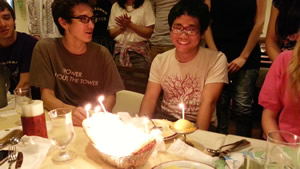
Arthur’s flaming birthday-Naan! (last week but still relevant)
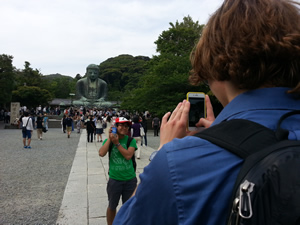
A picture of a picture of the Giant Buddha
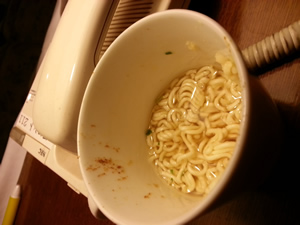
Cooking Ramen with the mug and tea maker in my room #creativemeals
Intro to Nanoscience Lectures
Dr. Bird was phenomenal. He used all of his time, and it was greatly appreciated. He really made everything come together. He went back to the beginning and explained what and why there were different properties in different materials and had a lot of great diagrams. It was a lot of the basic reasons for why everything in all of our future research would work and why it is so cool. It was a great way to end the lecture series.
This week was sad because the NanoJapaners are breaking up and “kore wa nan desu ka” can only get you so far.
I have been emailing more with my mentor and it sounds like he has a very good (yet flexible) idea of what I’ll be doing. A few of the techniques I learned at Rice I will be able to apply so I will not look clueless 100% of the time. They are just starting a new part of a project which I’ll be able to help with; it’s going to be another Bachelor’s student and I struggling through it together. And he says I am more than able to make suggestions if I have any or give something a try in the lab, which is great. Although I think he is over estimating my knowledge on the subject matter, from our emailing styles I think we will get along well. As great as sitting in classrooms for 6 hours a day was…. it will be nice to finally do something hands on. I am most excited for the amount of material I am going to have the opportunity to learn about, and my mentor has mentioned ping-pong multiple times, which is a big plus. I honestly hope I can keep up, but I’m glad that this situation will push me to work hard.
My first day surprisingly unsurprising. One of my mentors took me around campus, showed me where the bookstore and the combinis and the gym and the cafeteria were. It was really quiet (as usual). The campus seems very collegiate because there are quads and old brick clock towers underneath the 12 story research facilities, it’s really nice. The lunches at the cafeteria look cheap, bonus! In the lab we just went inside and came out, it seems like a very cool lab. They have a lot of equipment that I haven’t seen before. I brought my Lab Omiyage, but I’m pretty sure no one knew what it was so it just kind of sat there for a while, it was only slightly awkward. They had a welcome party for me! It was in conjunction with a farewell party for someone else. They did it American style because apparently Maruyama-sensei likes it that way. We had shrimp/tomato/basil, potato/meatsauce, eggplant/pesto/bacon, and avocado/ham/mysterious white liquid pizzas. They also had sushi and chips and drinks and candy. It was really nice to see everyone talking because no one really talks in the office or the lab. I did have a chat with Maruyama-sensei who seems more excited about my project than my mentors. It was a very smooth transition.
My project lab mentor is super cool. He is working on Silicon carbon nanotube solar cells and he is a post doc so he knows everyone in the lab and lets me know who to talk to about different subject. He is very friendly and talks to me about grad school and going around Japan and what he wants to be when he grows up.
My social lab mentor is super cool too. He takes me to meals and lets me practice my Japanese on him. I don’t work with him in the lab though. There is actually another Rice student in my lab! And I think we will be working together! RICE FIGHT NEVER DIE! We actually came from the same lab back at Rice, so fate has solidified my confidence that I am on the right path.
Everyone speaks mostly English to me. I think that some people may avoid talking to me because they don’t want to try to translate. My mentor speaks flawless English. It is a very international lab so most things are in English, except for lab meetings, which is in Japanese so I just look at diagrams for 3 hours and try to figure out everyone’s projects.
My housing is great. It’s a sharehouse that I share with 25 others. Our kitchen/living area is nice. My room is big, it even has a refrigerator. I have two windows, with curtains to block the sunrise at 5:30 AM. Even though my housing is more expensive, it’s probably worth it. I am living very comfortably. The supermarket is actually 5 yards away from my building. I think the surrounding area of Azabu Juban was nicer; it had more nice restaurants and clothing stores. I am close to the train station so there are a ton of food places and combinis. There is also a park at the back of my “neighborhood” where I can sit on Sunday mornings and have a picnic under the ivy and gently read over my scientific articles as the sun tickles my cheeks. I walk 40 minutes to Lab every day. Part of this journey is through a grave yard, which I walk through at around 9PM when it is black outside. *Shout out to google maps for giving me the creepiest route that also avoids tolls.*
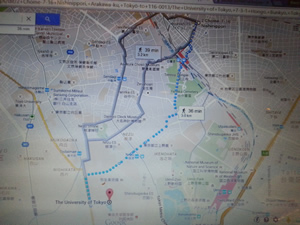
My route to lab every day.
I had a research project over graphene solar cells, and I just got settled into it and learned how to grow graphene, but I was switched to a different project on Friday afternoon, so now I’m back to being lost for a few days. It’s pretty stressful. You have to balance not knowing what is going on culturally with trying to remember everything that they are teaching you about the lab. And then there is some down time, but there is pressure to be productive (which I have been getting more successful at). It’s just a new experience to have an all day job.
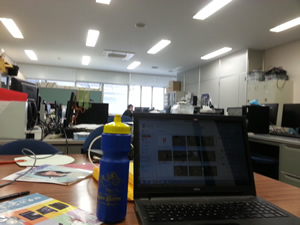
The new office space.
Question of the Week: Where do you eat when you get something from the combini and you want to eat it right then, but no one eats in public?
Overview of Orientation Program
It is very well organized. Packard-sensei is one of the most powerful and awesome people I have ever met. The Nagano trip was perfect. It was absolutely amazing, every tourists dream. There is time during the week for people to go to different parts of the city that they want to see. The lectures were probably the hardest part. Even if the lectures were interesting, it’s difficult to stay completely attentive for 3 hours after lunch, especially because we’ve already done three and a half hours of language classes for the day. I think this may have been better if we spread out the lectures to like a 1 hour lecture every day, instead of giving us some days completely free and others keeping us until 5. Also, the order of the lectures seem to be important because we actually had Dr. Bird last and his lectures were over some of the basic concepts that would have been helpful in understanding the first lectures. The professors were great, because I think I’ve taken the least advanced classes out of our Nano-Japaners, and they allowed me to ask my very basic questions. The culture lectures and the discussions with KIP students were probably my favorite. Also, Azabu-juban is a great place to house us. It is very convenient to all of the parts of Tokyo that we want to visit and there is the best bakery in the world right down the street from Sanuki Club. Did I mention how amazing Packard is?
The language classes were a little long, but it was necessary because we were trying to learn so much in only 3 weeks. I think that we actually did a great job for how much we learned. The teachers are great in helping us translate our American slang, it can actually be a pretty fun time. I don’t have much opportunity to practice Japanese as my mentor speaks English, but I did join a Frisbee team so hopefully I’ll get to practice there. My goals are to keep the same level I was at when we left Azabu-juban, because I definitely knew enough Japanese to get around at that point.
I [now] know that Japanese people don’t really ever deal with the concept of a vegetarian. Some key questions I still have are: How many physical subway trains are there? Are there swimming pools in Japan? Is there smog? It seems like there would be much more pollution considering how urban it is here.
NanoJapan Research Project Update
Research Project Overview
I will be making aligned carbon nanotube films through filtering. I have to build the apparatus and then optimize the process. There is only one person we know of who does this process, so we are going to try and improve the process he uses. This project is actually more tangential to our lab because we can’t use our film in any of our solar cell research (that we know of), so hopefully we will be able to get some results. We aren’t interested in the optical or electrical properties of the films, we will be focusing more on the mechanical side of why the tubes are aligning. HOWEVER, that is only my side project. I will be working with graphene to try and make the most efficient solar cell I can make. I think that I will be focusing on bilayer graphene and incorporating metals into graphene.
Research Methods
I don’t actually know much. I know I need flasks, a vacuum, a filter and carbon nanotubes. We will work on making a solution to run through the film that will be mostly water. We need to build the contraption and then try to make as many films as possible, and each film takes about 1 day to make. I will be making various solutions for us to run through the film making process. Different concentration of solutions affect how the nanotubes interact. And we are still brainstorming factors to change outside of the physical setup, to try and improve the process. I think this project will take a lot of discussion between the three of us which I am excited for.
Training
A very similar filtration setup is already used in our lab as we currently make CNT films. I need to learn the set up and then find out how different solutions affect the CNTs and I think that’s most of it. I had to learn how to grow graphene, which is what I love doing and it was the coolest 24 hour process ever. I have learned how to use the spattering machine. I still need to learn how to use the characterization equipment.
Timeline
We have not yet discussed a timeline because we are so early into the project, but he says hopefully I can work a little more before the last week so I am not struggling to put my poster together.
Questions or Issues Regarding your Research?
I’m not sure if there is a greater application for this project. I’m not sure what we can use the films for once we are done, so that would be nice to know. It will be different because we have no basis for what should be happening. We are trying to optimize a process without a standard. We need to think about why the carbon nanotubes are aligning. I originally believed that it was just out of convenience for the nanotubes because they are being vacuumed down, so the easiest way for them to be vacuumed down would be if they all lied in the same direction. As far as the graphene project, I think I will have a lot of fun because my mentor told me that as long as I have a little bit of science behind my decisions, I can try and do whatever I want to the graphene. For the graphene, he said I might get to finish up a few basic solar cell tests for someone else, which should also help me learn all of the skills I need for the project
Ah, “cross-cultural communications”. I have to say that specific situations don’t usually stick out to me because I would just call it “communication”. I feel like people put a lot of pressure on how difficult it can be to communicate in different cultures, but I think it is rather simple. As long as both parties have the mindset that no one is purposefully trying to offend the other, and we use really big hand gestures, we can usually figure anything out. In Japan it is a little more difficult, because their social rules are fairly strict, so people seem to get (not visibly) upset more often, or maybe they are just surprised when people do anything outside “the norm”. And because they don’t get visibly disturbed when there are “cross-cultural communication” mishaps, it is difficult to tell when there is one and leaves me (the unknowing-blissfully-naïve-American) thinking I am just a model citizen.
One (kind of) example that I can think of is a dinner conversation. (To set the scene) It was a warmly lit room, small, where we could barely fit our group of 8 people. It was a mixed group, a feeling of excitement as our group had just met for the first time. The usual smells of yaki-something and a slight fishy undertone danced across our noses. A fellow lab member and I had spontaneously decided to meet up with some students from another lab and go out to eat. Their situation was similar, it was a group from MIT here on various internships with some Japanese students mixed in. Everyone got along great as we introduced ourselves and compared our labs. It was great, because no one knew what to order, we used the point to random things on the menu method. It works if you can’t understand the menu or if you can’t agree, so I think I’ll bring that tactic back to America.
As we went back and forth trying to understand broken English and Japanese we somehow got to the topic of Spanish, which both groups knew even less of. So we were figuring out what everyone knew in Spanish and then it was my friend’s turn and he said something to the rough translation of “small innocent boy”, which we thought was random and therefore hilarious. For the next few minutes we switched between trying to figure out where he learned that one specific phrase and seeing if it applied to him. Somewhere in the middle, he figured out that we were kind of poking fun at him and his eyes got really big and he says, “No! You guys are laughing at me!” which we of course deny and profusely apologize for. In America it is so common to laugh at each other and yourself, that we just did it naturally. We did not give it a second thought, which is really our bad because not thinking is the easiest way to offend someone from a different culture. Because we thought he was actually offended, we immediately try to explain why we thought this was funny, but then he turns around and says, “If I am small innocent boy, you hang out with small innocent boys?” Which was even more hilarious! So this miscommunication turned into an even better communication scenario.
So throughout this night I learned that I should test the waters to see how much joking or sarcasm someone understands, as well as how fast someone can learn a new culture and laugh at you with it. It was a really fun night. Everyone had a great time using sarcasm after that. The Japanese boys understanding of English was so proficient that they actually used the fact that we didn’t know how proficient they were against us. They would switch words out when we asked them if they understood to make funnier sentences and would repeat things back at us incorrectly on purpose. It was great!
My question of the week may be about water supply here. I understand that we are able to drink from the tap, but I feel like water fountains are still great inventions. Either the water-bottling companies are in on this, or there is some secret information that Japan knows is better about making people find a sink for water.
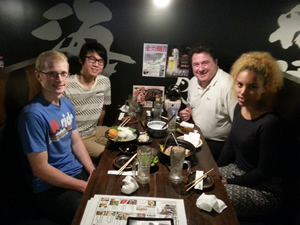
Rice Owls Meet-up with Prof. Matteo Pasquali
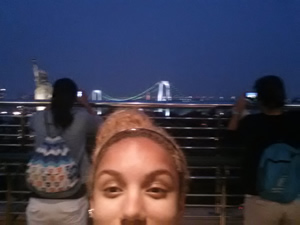
The most romantic spot in Japan, with my two best babes.
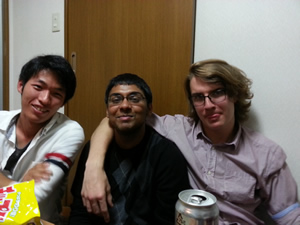
Reunited with some of the KIPpers!
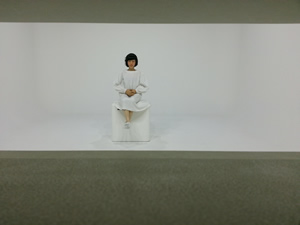
Japanese Android at the Miraikan
NanoJapan Research Project Update
I would describe last week as “learning” week over here in the “Brandi’s experience in Maruyama’s Lab”. Project progress is up to .01% thanks to the number of times that Team Brandi-Kehang can mess up an experiment. It’s odd, because I am definitely doing things in the lab, results just haven’t come up. I think that once we get the ball rolling (by the end of this week), it will go really fast. And Kehang and I are really excited about the project which is great. We can also laugh at/with each other when we mess up, which helps a lot. With this project the ball that needs to be rolling is weighs about a ton, because the parts of the experiment that we mess up take about 5 hours to redo. So once we get over this hurdle, we will be home free (knock on every single tree in this country because I don’t have time to not be over this hurdle).
So, going into the project. I am officially on two projects, which keeps me busy. Project number one is creating graphene solar cells! I really enjoy this project because there are so many components that go into it. Make the graphene, etch the silicon, sputter the silicon, transfer the graphene, improve contact, and measure. We are working on making a better etching solution which involved a lot of chemistry (my favorite). I actually had to use dimensional analysis and stoichiometry which I thought had left my memory forever. And, like a true mad scientist, during one of these trials, something even bubbled and started to emit a very strange odor; you have to love the trial and error method. This is really the most difficult part as I have already learned everything else that is needed for the experiment. Growing graphene was a really fun time because it was very similar to my project back at Rice, but more complicated. I was handed a printout sheet of instructions to follow, however, this was not detailed enough and led to me squinting intently at the CVD machine before going and getting help. The further we get into the project, the more I am allowed to do on my own, which worries me for the project.
A few times this week in lab I made some scientifically correct statements that helped shape our experiment. I felt incredibly smart even though they were more half statement-questions. As I learn more, I hope to find some techniques that I may be able to bring back to Rice because my work was so similar. I now know graphene CVD, sputtering, transfer of CNTs and poly-layer graphene, etching of SiO2 and TFOs, SEM, and measuring approximate efficiency of solar cells.
My mentor is actually leaving all of next week (could not be better timing since I’ll be gone half of the week for the mid-program meeting). He says we hope to have some results by then and that we can start the really cool stuff when we both get back. I might have to come in this weekend for some over time, but I don’t mind as long as it is necessary for the project. The hours that we work in the lab are a bit strange. I come in around 9:30am every day. I would consider this late, however, I am usually over an hour earlier than everyone else. It won’t be such a problem when I can do things without my mentor’s help, but right now I occupy the time by typing up methods and catching up on any literature. It is also difficult to make plans for after Lab because I never know when I am going to be released. Some days I think I’m going to be done early and then all of a sudden we need someone to wait for the CVD or for the etching to finish, and then I have to stay. This is not a complaint (most of the time), as I do love staying for the project, it’s just a little less structured then I am used to, and I think this may be prep for graduate school.
Questions: How many times can you drop a substrate before you need to start the cleaning process completely over instead of just rinsing with IPA? When your project takes twice as long, is it twice as much learning, or twice as much negative muscle memory?
Remember to celebrate the little victories, because there is a lot of “learning by mistakes” up ahead.
Outside of research, what has been your biggest personal accomplishment to this point? This could be something that may seem quite small, but that to you was a big accomplishment.
I started a conversation at work today! I had been contemplating talking to my desk buddy all week because I didn’t know if she was working, or if we were allowed to talk in front of the professor, or if I should be working instead of thinking about talking to someone. But I finally did it, and it was mediocre. I learned about the 17 Japanese words that I had written down tediously during my conversation contemplation. Not to brag, but only about 13 of them were wrong. They helped me plan out an entire conversation that I could have with the people with whom I will be speaking to at the place that we spoke about. (I’m being vague because I believe there will be pictures to come and I don’t want to spoil the surprise for all of my hardcore blog fans out there). My conversation partner was of course unwaveringly friendly and patient during my trials and I believe there will be many more broken interactions in the future.
What has been your biggest personal challenge to this point?
I truly thought coming into this that my biggest problem would be being alone. New country, no contacts, barely any audible communication. But then I remembered that I go to the greatest University in the world and talked to everyone I knew and they found me activities and friends and gave me just enough wavering confidence so that I could meet new people and try new things.
Even as a tot I scrambled across the floor of my house, of course there may have been no ultimate goal except to scramble at that point, but I have always been a “mover”. Now the most exercise I get is walking to and from the elevator. The pressure of being in a lab is overwhelming enough without having to have it physically sulk up the room around you. I am being productive, in and out of the lab, but it still feels a bit congested. At school I’m used to moving in between buildings throughout the day, and now I have two rooms for twelve hours. It is a great experience being a real person, but you get some things taken away because you no longer determine your only set of expectations.
How are you progressing with your research, especially with regards to your anticipated timeline? Are there any issues with your research about which we need to be aware?
Research is a slow process, in general, in my opinion. There is a lot of wrong in research, and the hope that you will find the one thing that is right, has to be enough motivation to keep working. I wouldn’t recommend making a structured timeline, because changes (mistakes) happen, a lot. Even in factors you can’t control, like equipment not being available, equipment being broken, people not being in lab. And none of those reasons are excuses for not making progress. So my main issue is most likely that my project is sort of unfocused, which I think is ok because I get to go a lot of different things. This will lead to me having fewer results than I thought we would have, as well as less deep results. The way we are trying to organize the project right now is a little mis-happed, and I think it may be throwing us off from pursuing one thing or another. The ever-changing project does keep me on my toes, which means I don’t take days off, and that’s inspiring.
Are there any other issues that you would like to discuss during the mid-term meeting that are related to the success of the rest of your summer in Japan?
I think we should just have a pump up session of compliments where we just remind each other how awesome we all are.
Do you have a 'Question of the Week' that you'd like to share/ask?
I have steadily been making my way down the aisle in the dollar store, which brought the inspiration for this week’s question. Which lab snack food will win the title of “best-snack-for-when-you-have-been-working-10-hours-and-you-need-food-to-love-you-because-clearly-your-schedule-does-not”?
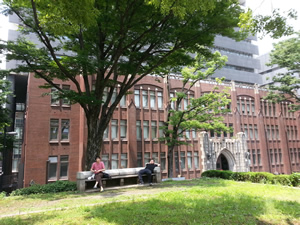
Ah, the lab, finally home after a few 12 hour work days
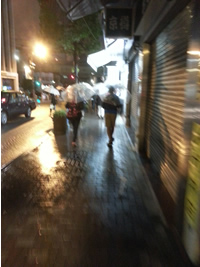
Rainy season has arrived
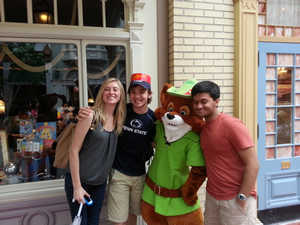
DISNEY YEY
Research Project Update
My project is still graphene solar cells, with the end goal being to try a few modifications such as bilayer graphene and copper chloride doping. This past week I made a lot of substrates (not all useable) because we are trying to make a more rough surface on the silicon. I really enjoyed this because I was able to do a lot of chemistry. It was a major throwback to junior year of high school chemistry class when we had to do basic molar conversions and stoichiometry. The process was also very cool because I was able to heat things up and watch them bubble like a mad scientist. So we finally found a compound that we think works, but my advisor also ordered a more controllable compound, so I might have to retry a lot of these things again after the mid-program meeting. I just hope that the new compound gives us consistent results.
I worked a lot with the SEM this week, since that is how we check if our project is working. It can be very difficult because I don’t always know what I’m looking for. I enjoy the SEM, I feel like a treasure hunter with no map and no idea what they are looking for, which means I get excited very easily when I find something, good or bad.
I was also able to do my own graphene transfer! Successfully! The process takes about 5 hours, so there is a lot of motivation to do it correctly the first time. This may be the 1/3 of the way point.
We also acquired another visiting member who will be staying for abut two months. He is fluent in Japanese and works with adhesion forces in nano materials at Vanderbilt University. What makes him really great is that he can give me tid-bits of info or explain the science behind my project to me, which means I don’t have to bother my mentor as much. He also understands my project, and has worked with similar texturing of silicon at Vanderbilt, so he gave me some advice that I may be able to implement. He spoke about a different chemical that could be used for our chemical etching as well as a different type of substrate that could be used in our solar cell that may accomplish the same goals as our etching. Kehang was super excited to hear this so we tacked this on to the list of things that are still the same project but on a slightly different path. Basically, I am always going to have something to do.
It is difficult to keep controlling our project. I just think right now we are trying to get through one complete solar cell before we do anything else, but it kind of scares me that we aren’t doing all of the trials throughout the project so that we can adjust things along the way. I think it may hurt us a little in the end. If we don’t have a solid foundation, trying all of the cool special projects won’t be reliable. We were hoping to be slightly further along in the project, maybe one more day here would have worked, but with the amount of work we got done last week, I think we are moving at a very respectable pace. Luckily we won’t be relying on my graphene growth for this project, just because there are already a lot of time consuming processes, and my graphene isn’t of the highest of quality. We are running out of chemicals, which means I have to take a break so that we can order more. I guess that a major setback would be that during the lab meeting one of the sensei’s said that they think our hypothesis is wrong and we will have the opposite outcome, but luckily, science allows us to test these things. If it turns out that that part of our project doesn’t work, we do have a few alternatives, or we could still complete the second half of the project without worrying about the first, so it won’t slow us down too much. My mentor and I are constantly talking about the project because there is a lot of trial-and-error, so I think we adjust to things very well.
Bad results can be just as helpful as good ones. We tried four different solutions and none of them worked because reaction timing and temperature control are so sensitive.
Learning Japanese is not near as difficult as learning English. For only three weeks of a course, I think we learned an incredible about of material. During the orientation they definitely taught us the important phrases that we would need for getting around. Although they are pretty set phrases, so we are limited in the depth of our conversations. At the end of the orientation, I was confident that I would be able to survive without eating anything that I didn’t want to.
A lot of people here know English to some extent, so it makes it much easier on us. Sometimes I really want to practice Japanese, and then people just keep going back to English or cut me off in the middle of the sentence because they don’t want to wait for me to try and figure out what to say. It is also difficult to form sentences because we have a very limited vocabulary. And learning new vocabulary is difficult because I usually only need it once and then google translate tells me the wrong translation so when I try to use it people get confused and then I get confused over why they are confused and we both slowly bow-walk away from each other in mumbles. The best practice I get is when I am forced to speak Japanese, such as in restaurants or when I go out to lunch with my lab mate. Repetition is really difficult to have time for, because in lab I am in a lab, by myself, and I can’t sit around chatting with everyone for really any period of time. I am finding more time as I get into the routine of things here. So I don’t speak much Japanese, but when I do, it is also basically not Japanese because I’m not sure what I’m saying, so that’s reassuring.
There are very limited experiences with linguistic issues in Japan. I know how to ask if people understand English, and also how to say that I understand only a little Japanese. This puts us on the same page about how the interaction will proceed. If you start off with this I find that people are much more patient. So then the conversation in broken Japanese/English starts off slow and sad, because no one has hope for the future of the interaction, and it ends up enthusiastically positive. I am not a hugger, but every time I have a successful communication, I have some very intense bowing or high-fives or jumping feelings towards the other person. So moral of the story is, set the bar low, and use a lot of hand gestures. The most challenging experience is when I try to say something, and then the other person corrects me. It is just a really rough time.
At first, I was really hoping to just avoid communicating with people all together in this country. I didn’t understand why it was necessary, especially because I am in a very international lab. I clearly didn’t fit in with any of the Japanese culture, so I was hoping to just slip out of the country at the end of the summer with my American-ness untouched. But then, you start actually knowing people. Speaking the same language is one of the best options for getting people to understand what you are saying. Big hand gestures do help me burn a few more calories, but getting your exact idea across is impossible without know the connotation-translation. Hopefully back at Rice I will be able to take at least some intro to Japanese courses. I was also planning to study abroad while in school so I think that coming back to Japan is definitely a new goal.
The Mid-Program Meeting was held in one of what society would call the most relaxing settings ever. And I got a total of 15 hours of sleep over the course of the 5 days. It was really fun, a nice break from having to plan out research experiments or having to stay very late in a confined room. The conference was my first, so I learned about how things are organized. Luckily my presentation went well, but the entire process was very mundane. I only knew what others were speaking on about 35% of the time, and there was a lot of sitting, but none the less very interesting. I was once again impressed by how dazzlingly smart everyone in our group is. And we all are good presenters, so I like to think that the NSF would be proud. I think that for the rest of the summer I am going to keep working as I have been. I may press my mentor a little bit harder to define the project at the end, but I actually like just working, and seeing where things go. So I will blindly continue to work towards and undefined goal.
OIST makes me excited for the future of the world, because they had everything that everyone talks about. If you would take a tour it would follow the following. “Welcome to OIST, where we figured out how to define cool. First, we will impress you with our amazing architecture that makes you feel like you are at Nike headquarters. Around the next 7 turns we have state-of-the-art everything, to make sure we are always being productive. Outside you’ll see our amazing housing for students and faculty accompanied by a gym and supermarket, because we actually care about our associates. Through our admissions and bylaws, you’ll see that we actually practice diversity, and encourage cross disciplinary study, we don’t just put it on posters. And of course, this is all .5 meters from a gorgeous coastline.” The conference made me realize which parts of this subject that I am interested in, and that it may be broader than I expected.
Question of the week: Why do people apply to graduate schools besides OIST?
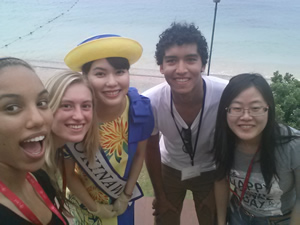
Picture with Miss Okinawa!
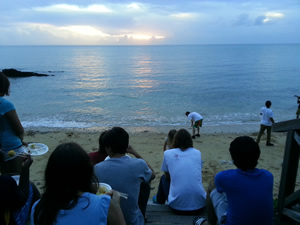
BBQ on the beach
Research Update
For this Monday and Tuesday, I found a new etching solution that worked really well, so I’ll get to try the solution using real silicate when I return. This was a very exciting moment. Also, I failed and graphene transfer and growth, so no results to report there. The good news is, in preparation for MTSA I actually understand more of the science in my project.
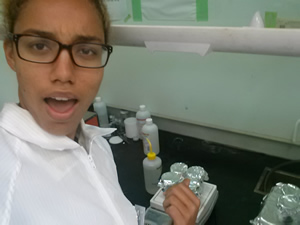
Science! With almost no results.
I think labs here would be similar to a very difficult and confusing job, rather than a research lab. The expectations here aren’t necessarily higher, but they don’t give as much information as to what is going on. So you have to try and stay 5 steps ahead of what your mentor might be thinking, because things are expected to be done even if they are never discussed.
Writing down rules for the lab is a difficult task considering the amount of communication that goes on academically between colleagues is at a minimum, much less social communication. Starting with the Sensei, he is basically untouchable. The post-docs barely talk to him, the associate professors only get directions from him, and everyone else sits quietly and hopes not to be called on. If sensei asks you something, you are expected to have a 30 point plan of what you are going to do, and laugh at all of his jokes, and agree with everything he says. You actually should know what he wants you to say, and say that and nothing more. Sensei is almost mythical as all we say is, “sensei is very busy”, but no one actually knows what he’s doing. Everyone else in the lab is approachable, but you only approach people if you need help with a very specific problem and you have already asked your superior to ask them if it is ok to talk to them. And when that person gives you advice, there is no discussion, you just take the advice and thank them generously. Socializing in the lab or offices is unheard of, we are all working, all of the time.
It is hard to judge how similar the situation is to what we were told before we arrived because I rarely get feedback from anyone in the lab. I assumed it would be more structured than how it is here, although I guess there is structure, just no one ever talks about it so you wander around like everything is ok until you slam into a support beam. The previous NanoJapan Students did mention how hard they worked, and I just thought they were kidding, but I think they were under selling it. On top of the hours put in, there is a lot of pressure to want to keep working because you don’t know if you’ll ever have enough information at the next lab meeting.
People here want to make sure that you are doing things the correct way. They focus much less on the results. They give you a thumbs up or down for the results and then analyze your methods. But the analyzation isn’t for learning or for interest, they are just checking to make sure you did the procedures the most normal way possible. They don’t want anything fancy, just basic, using papers that are basically approved by your mentor or sensei. They also care about the presentation of the results more than the results. If your presentation isn’t formatted in a certain way, sensei would get madder about that than if you said you got a negative result after 6 weeks of working on a project. I think America is more focused on finding new results both in an end product and in the methods. It is much more individualistic in America. People really value collaboration and input and constant adaptation, but it is still an individual’s project. In Japan, it is the sensei’s project that you are working on and you follow instructions. So creativity is a big difference.
It seems more frustrating in Japan because there are many high expectations that no one tells you about, but you also have less control over your own project, and the two ideas contradict each other. I can’t compare the two experiences all that well because in America I was more just doing work for a lab, not really working on a project. I am also not sure which social atmosphere I like better because I don’t take part if there is one here, and I didn’t take part at Rice. For right now I am going to have to give the point of work-life-environment-balance to team American Labs. Also, I think things would get better with time. A big part of this may seem negative, but that’s because I worked 68.5 hours last week and I’m a little bitter. We did finally get started on the project though!
This week in lab I was working really hard, or so I thought. In the lab meeting, I gave a presentation. Sensei was so upset that you would have thought that I physically harmed someone or broke an expensive piece of equipment. I didn’t explain things correctly, the format of my presentation was wrong, I didn’t have enough information about the right parts of my presentation, and then at the end the professors mentioned, again, that they didn’t think my project would work at all, besides the fact that I wasn’t working hard enough. Maybe I have just been coddled in America, but it was rough.
This week, question goes into life in general. Should you be on time, or take the long way, or is there a “happy medium”? (Yes, I do need to get my priorities straight.)
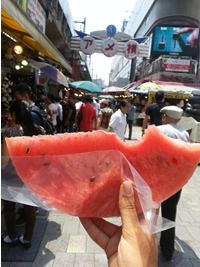
Good day!
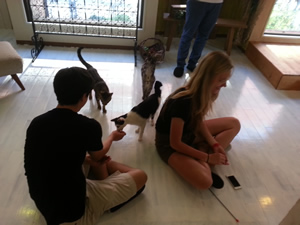
CAT CAFE!
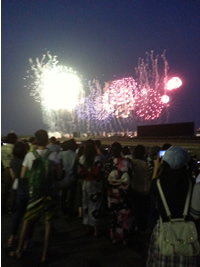
FIREWORKS FESTIVAL!
Research Project Update
After working through some real research-esque situations (trial and error), I have finally finished (perfected), my substrate solution. I can now reproduce however many substrates we will need for our solar cells in a mere 4 hours. We may only need the two that I made, but it will be good to know for future reference. I am so proud of these substrates, the only people who get to look at them are me and Kehang, or else they live in my drawer on a very high shelf.
That was the big hurdle that we were waiting for in order to move forward with our project. I have a lot of repetition in graphene growth and transfer now (because there is no limit to how many times you can mess up a procedure at the 95% mark), so that won’t be a problem when the time comes to make actual solar cells. Now we have some intermediate tests we need to run before we move on to the final product.
Part of Project |
Test Needed |
What Are We Testing? |
Etched Substrate |
SEM Imaging |
Checking the etching pattern |
Graphene Growth |
Raman Mapping |
The number of layers of graphene |
Graphene on Etched Substrate |
SEM Imaging and Raman Mapping |
Looking for contact between the graphene and substrate |
CNT Cell with Etched Substrate |
Efficiency test |
Testing the substrate |
Graphene Cell on substrate |
Efficiency test |
Testing the graphene |
Graphene Cell with Etched Substrate |
Efficiency test |
See if we saved the world |
The mistakes this week were mostly in my presentation, but coming up, the next parts of the project are do or die. As I go down the table above, if one of the parts kicks back negative results, the project will basically stop at that part. Because of the nature of the components of our cells, I believe accurate data may be difficult to come by. For the graphene, it is very easy to get contaminated results because anything from the air can land on the substrate and compared to the 2-D material, that particle would be huge. If we have good results using my graphene on the first few parts, then we will have the graphene expert in our lab grow us cleaner and even samples. Trying to measure the efficiency will be difficult because the etched substrate doesn’t have optimal contact with our efficiency measuring device, so we are currently working on solving that problem.
Overall, I’m just glad to get going on the project. If all of the test go well this week, it shouldn’t be too hard to collect data and hopefully I will have a well-rounded project.
I interviewed shinnosuke! He actually goes by another name, but he cut me some slack because I’m foreign. Shinnosuke is actually the student who helped me move in to my house in Japan, and he might be the person I’ve spoken most to in the lab at a grand total of 4 times. Shinnosuke is an M1, Master first year. He is studying mechanical engineering even though everything we do in the lab is materials science. I am not sure what his project entails completely, but I know he always mentions carbon nanotubes, so he is on the cutting edge.
Before entering university, he said he really enjoyed chemistry, and I related overenthusiastically as I have also dabbled with baking soda and vinegar combinations. He intended to pursue the same career track (getting a Master’s) in chemistry, but when he began taking university courses he found them extremely challenging, and so he became discouraged. During his second year, he took the “high-achieving pupil” exam (direct translation). Every university student, at least at Todai, must take this exam in order to be placed into their major. Along with completing course requirements, students must score at a certain level on this test to be placed into more difficult majors. Chemistry required a very high score, and mechanical engineering did not, so Shinnosuke decided to enjoy life and ride on in to the engineering program. This is plot twist/difference from America number one. Of course chemistry is a very difficult major, but I feel as though so much emphasis is placed on how engineers are “changing the world” in America that if we had to take tests I think engineering would be close to the top. Either way, this test score brought Shinnosuke to his undergraduate major of mechanical engineering, which he believes has a very high test-score-to-good-job-getting ratio. Un-plot twist number one, people in Japan choose engineering because they know they’ll get a good job, just as in America. When talking about the rigor of his undergraduate career he said, “Japanese universities are not a place to study, and then in master’s you do a little study”, so I was then a little confused. Earlier he said, that chemistry was too hard, and then he said that you don’t really study in school. I’m interpreting this to mean that Japanese universities are more difficult than those in the US. Overall, Japanese universities is structured a little bit differently than the US, but the motivations seem to be the same.
Going on to get your master’s is where we encounter plot twist/difference from America number two. In Japan, getting a master’s is necessary to get a PhD, however, most students will not get a Phd. The only reason that you need a PhD in Japan is if you are trying to go back into academia. You can go into research with only a masters, so if you have a master’s you will definitely get a good job and you don’t need to go through any extra school. In the US, it seems like we would rather skip the master’s if you are going to get an upper level degree (in some fields). Master’s students in Japan are getting a master’s because they know it isn’t actually about the research, they are just getting through two more years of school for a better job, which is un-plot twist number two, the upper level degrees are used to get a better entry level position. Throughout the master’s program in Japan the students take classes, which were described to me as “we write a lot of reports”, and participate in research, which we agreed was “working a lot to get almost no data”. I can’t speak too much of the classwork except he was working on a report at 9 pm when I was interviewing him. The lab environment was very liked among the master’s students, who cluttered around me when I began talking to Shinnosuke. They say the best part is that they have each other (cue emotional music), and they are also very appreciative that they have equipment in such close proximity to their lab. They perceive American labs to have more money to spend on research, however, they think that it is terrible that we have to walk to different buildings on campus to use different equipment. Also, even though they think we have more money, they think we have worse equipment, so maybe we should take another look at our budgets. This discrepancy between countries most likely comes from the fact that Japanese universities have research that is funded from the government, whereas in America each lab has to apply for grants. Talking specifically about the place where we spend over half of our days was getting us bogged down (note the “very little data” comment above) so we moved on to the personal interactions.
There are many Japanese students who are interested in studying abroad for their master’s, however, because they are so shy, they become discouraged from applying. To quote Shinnosuke, “I was scared there would be too many international students in the international lab.” So the very reason all of us want to study abroad, is what stops Japanese students from studying abroad (plot twist/differences from America number 3). He did say that all of his encounters with international students in our lab have shown that they are very passionate and hardworking at their research. I believe this ties into the sort of going-through-the-motions vibe that I get from the master’s students and that is hopefully aforementioned in the fact that master’s students care less about what they are doing and are more just surviving the two years so that they can get a better job. Hopefully this passion that international students seem to possess will attract more Japanese to study abroad!
We didn’t talk much about me or America during this conversation, just because it was late, and as I said, he had a report. He only inquired about my opinion of Japanese people, and if it had changed. The answer to come in future reports… (start ominous music and slowly fade it out).
Question of the week: How much Indian food is too much?
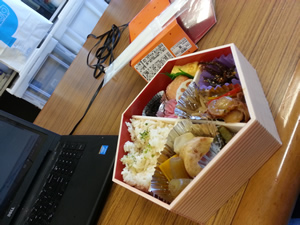
Lunch from a conference
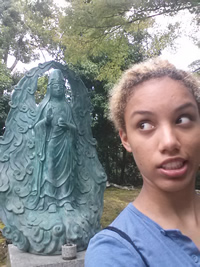
Another statue that I'm not sure what it means...
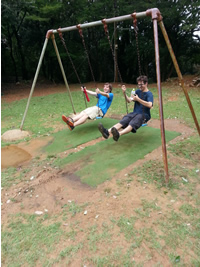
Cuties!
Research Project Update
My etchings turned out to be very good, even sensei said so. It might have been the first positive response that I have received this summer. I have replicated the results multiple times now, so I know we will at least have stable etched samples. Sensei is even letting me make etched samples for someone else’s project. I keep attempting to grow graphene, and I have some good samples, but I feel like I should just wait for the professional samples.
I feel like I’m always working and don’t have much to show for it, which is sad. This past week we changed my project to not solar cells. Because they feel the project would take too long, they want me to try and go through a larger part of a smaller project. I will be focusing on the contact between the CNT films or graphene and the etched silicon substrates I have been making. I will also try to make a map about which part of the etching solution affects which parts of the etching. We may also do some non-etched solar cell testing with doping, but our lab is hosting some sort of seminar this week and I don’t believe I will have time.
What got me off of the solar cell project was ironically our first completed solar cell. We tested the efficiency on an etched substrate solar cell, and it was very low. However, with SEM images and Raman, it looked like there was good contact between our substrate and our hole transport layer, so we were a little confused. I thought it might be the contact between the stage on the efficiency measuring device. Either way, we discussed maybe using some conductive polymers (credit to Caitlin Miller) or silver paste to help this contact.
This past week I did a lot of etchings, however, it is still not enough to make a well put together graph. There are so many variables that I could test that it is going to take a very long time to go through even a few of them. Beyond that, the amount of materials that I need in order to perform the etchings is not small. So there are days when I can’t do etchings and work on a different part of the project.
I just wrote the above, then went and talked to my mentor. He said I’ll be working on solar cells, hahaha. For the cells we are going to try and correlate pyramid size with efficiency. We don’t expect to make an overall more efficient solar cell, but we do expect to find a relationship. This week is going to be difficult as out lab is hosting a seminar that my mentor had to prepare for and speak at. Because of the confusion above, I can’t say that my abstract will be too trustworthy.
Working in the lab can be difficult as there always isn’t someone to help you. And when I try to fix it myself, it doesn’t always go so well or I don’t trust my result to be as accurate. I take smelling gas or smoke as a gentle reminder to stop. Many (all) of the sub parts of my project take hours (6 hours) to complete. Many times I have made mistakes when I am hours in, and then I have to restart, which can be frustrating. Or if something isn’t working, and you don’t know if it isn’t working enough to accomplish the task, or if it has one more good go in it.
For the last two weeks, I just hope to get a realistic experience for preparing for a conference. I think my mentor and sensei are more worried about getting a complete project done than I am. I really just wanted the experience of working in a lab, which I am getting no matter what. Especially with the craziness of un-definition in my project, I am very happy with any data we collect. I know I’m here all of the time, so it is strange to not have anything concrete.
I realize that researchers want to publish their findings very quickly, but I feel like diagrams are the more difficult mistakes to make, because they are so visual and there aren’t that many of them. I would be more skeptical of the two researchers who helped Obokata write the paper. If they did want to edit the paper it would be less-risk, high reward for those two, because they were only helpers. If she replaced one of the lanes in the electrophoresis gel picture, why didn’t she just replace the entire picture with the picture that includes the lane she switched out? It also seems like this would have been easy to investigate. All they need is both original pictures to see if it really was just a clearer piece of an image that is almost identical. Using the picture from her thesis does not make sense, the experiments are not the same. She could have used it as a comparison in the paper, to show how her experiment gave similar results, but another picture and caption would have been necessary. I do not believe that these pictures should have been such a major part of the investigation. Even if the pictures are completely wrong, you don’t follow two pictures to accomplish the experiment, they should have focused on the results.
I understand that people are saying her experiment doesn’t work, but there is a quote in one of the articles where one of her helpers claims something along the lines of, “even with the mistakes people have found, some things can only be explained by the STAP cells.” Japanese culture is also very “group think”. If one person found inconclusive evidence, and then someone else found something half way inconclusive, the group if now two against one against Obokata. From my experience in Japan, the majority of people who attempt the experiment after this would want to side with the majority against Obokata. Because of these two reasons, even her experiment truly doesn’t work, I believe the entire situation is being dramatized. I have spoken with people before about the situation where papers get peer-reviewed and the results come back negative, and they say that the paper just doesn’t get published, or it gets revoked. They didn’t mention that you needed to have international news headlines drawing attention to the fact that you have failed miserably. However, because she is a Japanese female, it is less surprising to me that they would want to publicize her mistakes.
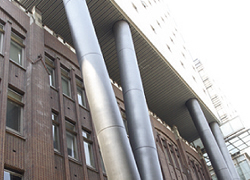
I didn’t take any pictures this week, because I was working all of the time, so this is a picture of my building, it’s pretty cool.
Research Project Update
We have real results again! I finally feel like something has been accomplished, although I wish the work-to-results ratio would be a little higher. Writing my abstract was very productive, because I believe it made me learn parts of the science behind my project as well as define my project so that it had to stop changing, and we could spend the last week working toward a single goal. And I am not so concerned to have good results, I just am glad that it is defined well enough so we will have a response to our hypothesis.
This past week was a full blown solar cell making process week. I made more substrates. I am able to control the different size of the pyramids by manipulating my etching process. I have done the etching process so many times in the lab that I can tell whether or not my etching is successful by looking at the substrates in normal light, without SEM pictures. Now we have an array of different etchings to test, both for the contact and solar cell efficiencies. I am excited that the etchings are such a significant part of the project because they are the part that I spent perfecting. After the etching I used the sputtering machine multiple times to make the solar cells. I think that sputtering will be the part of the project that I miss the least. Although, I do believe that I earned credibility points when I was using the machine (correctly) while they were giving lab tours to students from Beijing. I finished off the cells with their hole-transport layers and with that, my project finally has real data.
I don’t want to talk about the data in the report because now we are still taking data and I feel that it makes it less special. The project is stable now though, so I’m just making cells and testing them, rather than trying to define what the project is or what we can do. My goals for the project include running two rounds of tests on two cells of each type, just to confirm the trends that we see. Each round of testing includes three different tests, and I believe I’m about half way done with the tests. I am just happy to be done with the cell fabrications, so now I only have to do transfer and tests. I will have something to put on the poster!
In the news of things that went wrong in the lab this week, I did not break any machines. I only had to redo two of the processes this week, which I think is a new record. There was a slight miscommunication between my mentor and I where, somehow, he came to the conclusion that I have basically ruined all of the samples and we could no longer work on the project. Luckily we sorted that out.
I am not sure how I will deal with leaving the lab, not in the emotional sense. With research, I have a drawer full of samples now, and they are very cool, and I kind of want to keep them, but I don’t need them. Even if I take them with me, I couldn’t use them for anything, but I think I will take some just as memories. I don’t think that the lab needs my samples or even my data for reference. I don’t think my project will be picked up by any of the other members after I leave, so no one needs the samples; the data is all really on the computer anyways. I’m not sure if I could continue the research at another lab if I wanted to, or if I could use the results that I found at this lab in other research. Nothing is public, so I’m not sure where the boundary is on sharing data.
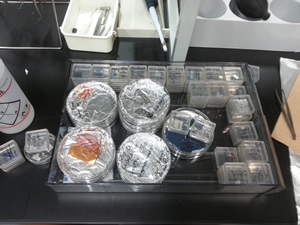
My goals for the upcoming week are to run one more type of test that I think is necessary to round out the project, and it will take an entire day. I feel like I could have a decent schedule this week for my lab work, I have tests and transfers on Monday and Tuesday, the test I would like to run on Wednesday, and then we have some days just in case any devastating mistakes are made.
What has changed the most about your perceptions and attitudes towards Japan?
I don’t believe that the quietness is completely cold and emotionless. I couldn’t understand how people expressed themselves at the beginning of the program. I understand now that you form relationships in Japan just by small interactions and being physically in the same place as people.
What has changed the most about your perceptions and attitudes towards the US?
I appreciate diversity so much more now. There only has to be two different types of people (even if they are twins and they just dress differently) in the same room for me to appreciate individualism.
What has changed, if anything, about you personally? Are you a different in any way from when you first came to Japan?
I re-found my determination to work hard. I don’t feel like I’m much different otherwise. I learned what it feels like to be a complete outsider.
What were the most common daily frustrations you experienced with living in Japan? What did you learn from these experiences?
I was frustrated that my wardrobe didn’t match all of the other worker bees on my daily commute.
What will you miss most about living and working in Japan?
I will miss Kehang, my mentor. That’s pretty much it. I did enjoy buying groceries, so I will miss being an independent person.
How did this experience affect your attitudes towards academic research and your career goals?
I feel like I can’t compare the experience with an American career because there were so many different factors with the culture.
Describe your final week in the lab. What arrangements have you made to say goodbye to and thank your research group or those who have assisted you during your stay at your host institution? Did you have a going away party?
My last week was probably my easiest week in lab. I didn’t have to say goodbye to anyone except for Kehang because I didn’t talk to anyone in the lab, and I don’t think any of them noticed that I left. We had a party which was nice.
How did you close out your research project and do you plan to remain in contact with your research group and/or host? Do you plan to continue this research project or research in a related area upon your return to your home university?
I might continue a specific part of my research project, but it is to be determined. I stopped my project pretty abruptly so I haven’t had a chance to close out with my mentor in a scientific way.
What are your plans for your final weekend in Japan?
Katherine and I went to Taiwan and it was amazing.
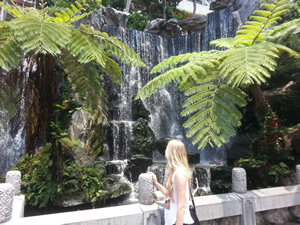
Question of the week: Is Taiwan cooler than Japan?
Transferring Carbon Nanotubes and Graphene onto Antireflective Surfaces for High-efficiency Solar Cells ![]() 1st Annual Smalley-Curl Institute Summer Research Colloquium Undergraduate Poster Prize: Third Place
1st Annual Smalley-Curl Institute Summer Research Colloquium Undergraduate Poster Prize: Third Place
I worked in Maruyama’s Lab at Tokyo University. My mentor was Kehang Cui, a Post-Doc. I worked on transferring graphene and carbon nanotube films onto antireflective surfaces to create solar cells.
Introduction: There were many different aspects to the process. I needed to find a stable way to control etched substrates. Then I did a different transfer of graphene onto the solar cells. Then I did doping of the solar cells. We were just experimenting with ways to improve solar cells.
Approach: The vast majority of the project was just making the solar cells, so the methodology was making substrates first, then making solar cells, then transfers. That part actually took so long that we didn’t get to make changes and re-test the cells. I performed chemical etching, SEM, sputtering, raman, and efficiency testing.
Results: We discovered relationships instead of saving the world.
Discussion: We discovered an entirely new problem that deals with the flexibility and contact of the graphene and carbon nanotube film.
Future Research: Just more testing to back up our results as well as changing the variety in our tests to make more concrete correlations. Also, we can test the properties of our substrates separate from the solar cells to see if their function can be carried out.
Conclusion: We can see that doping solar cells is effective across different surfaces. Further testing needs to be done to look into the flexibility of graphene.
The NanoJapan program was an immersive experience. Looking back at it now, I only remember what I learned (both scientifically and culturally) and the people that I feel comfortable complaining to. On the NanoJapan website there is a description that is very enticing for students looking for an incredible program (it was actually voted one of the best programs as it says on the webpage), and I wouldn’t say that the description is incorrect; I believe that they could add more information.
The first edit that I would make to the provided information is the name, currently “NanoJapan International Research Experience for Undergraduates”. While it may seem fairly straight forward, I once again believe that a caveat should be included. Undergraduates is such a broad word. This program requires a group of special undergraduates, which I believe the application committee does a good job selecting as well the program does developing. If you weren’t the type of person who can handle very specific situations that arise repeatedly as a side effect of being in a very different culture for a significant period of time, you will be by the time you leave. The people that I met in this program were some of the strongest people that I have ever met, and I would be honored if people compared me to them in any regard. Not only did the 14 of us learn to live in Japan at a ranking slightly above a tourist, but we had to learn to live with each other. Everyone was everyone else’s support system going through this program because we wanted and had to be. There are very few people who will understand the experience that we went through, and when calling people that you hadn’t met three days ago isn’t an option because of a 14 hour time difference, you learn to cope. Luckily, differing from what I’ve seen can normally happen when fourteen people in close quarters, we indulged each other. It was fantastic to be able to empathize alongside people who turned out to be the friends that I needed to have on this trip. Of course, problems can always arise when closeness is forced upon a relationship due to the foreign circumstances that can make a country feel like you are the zoo exhibit. However, our group was open minded enough that we were able to resolve issues by having legitimate adult conversations, which was incredibly refreshing. These conversations allowed me to see cultural differences across Japan and America and were mostly calm conversations. The rarity of which such a diverse group can get together and have discussions about how our differences don’t make us enemies is one of my most cherished memories that I will take away from this summer. The students that were selected for this program are the type that are confident yet humble enough to resolve issues without making every issue black and white. The gray area is what makes these undergraduates most equipped to handle NanoJapan, and it is what I thank for facilitating a large portion of my personal growth this summer.
NanoJapan can also prepare you for what grad school* may be like, it gives you a real world research experience**.
*Grad school is nowhere near encompassing enough for what NanoJapan prepares you.
**The program isn’t so much an “experience” as it is an undertaking.
Luckily, the program prepares you to communicate very extensively. I would feel comfortable going into a room of people where there is no commonality in language, and still being able to communicate, because I’ve now experienced it many times over. Life doesn’t stop just because two people can’t speak to each other. I feel that being dropped into a place where few people speak my native language has made me more articulate in English, because nothing is as difficult to communicate as technical Jargon in a foreign language. I believe I know how to simplify and present information in a way that can be understood by everyone who speaks English, and even people who don’t speak English if I use hand gestures. However, the most common explanation that I have encountered back in America is explaining my summer experience (once I get past the people who only actually want to hear “good” for politeness). I can recite the denotation of the NanoJapan program to people in America, but when they ask me any deeper questions about my time abroad, I find myself more lost than when our group would try to meet up at one of the most popular intersections in Japan with no cellular communication.
When speaking to my friends back at Rice, I usually opt for the shortest answer: “it was hard work, but I learned a lot and would definitely do it again.” Most people don’t care or know enough about the scientific part of my research, but they don’t want me to lie, because we are friends. If they probe any further I just let them know that I spent a lot of time at the lab and that weekends were my favorite part. Family is probably the easiest to speak to, because I am able to speak about almost everything that happened in Japan. This is where I speak about the extremes of my time abroad and give my most honest opinions. With my family it is even less scientific than with other Rice students, but we get more into how I coped with the various cultural differences. I haven’t encountered any faculty who are dying to hear about my experience yet, but I would assume that if we met, the conversation would be quite short. I would let them know that I enjoyed the change in culture and tell them an overview of what my research was. If they were in the materials science field, we might discuss what my future plans are, and if they are in an unrelated field, they would say “see you around”. The most difficult interaction is when you speak to someone who has significant control over your future, either yourself or an employer. With yourself, it is being truthful in your evaluation and comparison to what you believe the real-world will be like, because no matter what it is, you are now definitely more prepared after NanoJapan, however you have to use the information to decide how you would like to proceed into the real world. In a similar fashion, you have to decide how you would like to shape the experience for possible employers. For a technical position, and after speaking to a few people at our final colloquium, I would find it hard to believe if they actually cared if you were in Japan at all. Especially considering the fame of the NanoJapan program at Rice, they already believe that you were working in a reputable lab, and are only concerned about how the research affects their research. In this case you basically give the five minute poster presentation over your research. Within thirty seconds you will be able to tell if they are interested or not. Everyone responds differently to different answers, so it’s great that NanoJapan prepares you not only to read people very well, but to adapt at an astonishingly fast pace.
Adaptation definitely ranks in one of the top skills learned in the underestimated “experience” of NanoJapan. The fact that adaptation was only one of so many skills is what makes the word “experience” seem underwhelming. An “experience” is something that happens to you, it’s not active enough to represent the NanoJapan program. If you approach this program with the mind set of doing nothing, then it would be an experience, and you would still learn a ton, however, the NSF has high expectations. The expectations that your sensei and lab mates put on you are insanely nonexistent. You have to have initiative to start any work in the lab, or else they want to preserve you like an American artifact and not have you move a precious finger. On the flip side, as soon as you do work, you will not be able to stop. You have to learn how to read between lines that you have to create, because sometimes your main communication is them asking you questions, and you HAVING the answers. The time constraint teaches you to try and work ahead and to work more broadly because if you aren’t answering questions with “yes, and I am going to…”, it comes off as if you are back tracking. Students in this program are able to handle this pressure not by experiencing it, but by taking advantage of opportunities outside of the lab. It is very easy to say Japan is great, and that you are being cultured just by being in the country. However, our group went out to different cities basically every weekend, participated in raw Japanese culture, two of us even went to Taiwan. The people chosen for this program already like doing things, but putting fourteen of us in a country that is unfamiliar promotes the idea to take advantage of opportunities. With complete confidence I can say that the 14 people in this program got all that they wanted out of their three months.
After returning home, it is hard to shake the mindset that I had in Japan. I’m still trying to figure out what I have to do differently to be able to survive the schedule that is supposed to be taken by a Rice student. In a few ways I feel like I had to become a different person while I was in Japan, and so I have to figure out how to get back to my usual self. I am also trying to reorient my future as Japan has left me more confused than ever about what I would like to do with my career. Japan was a great place for me to learn about research, however, the culture shock was so great that I can’t compare the atmosphere to what it would be like if I worked in an American lab. The culture shock, although daunting, was the perfect way for me to learn about another culture; I will definitely be attempting to study abroad for at least three months again. Hopefully I will have the opportunity to practice a little bit of Japanese with people from Kono-sensei’s lab and perhaps a class in the future. Japan will always be a part of me, and I wish that I could keep more of the mannerisms from Japanese culture, however, in America I wouldn’t survive because the bases of both cultures are so different. Although I can’t bring back social norms, I did bring back a new perspective. I am more open-minded than ever to different ways of thinking, speaking, and acting, and I am excited to see how becoming a more absorbent person will allow me to fully appreciate and actively engage in the world.
Final Question: You can take the Gaijin out of Japan, but can you ever take Japan out of the Gaijin?
Pre Departure Tips: Earthquake preparation, this was huge. It isn’t gone over in the pre-orientation program, so I would recommend watching a YouTube video and figuring out what fire doors are.
Orientation Program Tips: Make friends with the NanoJapaners, it can be lonely in a foreign country, even more so if the other 13 people who know exactly what you are going through aren’t available.
Mid-Program Meeting Tips: You might not have any data; present as if you are already done with the project.
Working With your Research Lab Tips: ASK QUESTIONS. Lab work is hard, and long, and communication can be difficult between you and your host. Expectations are especially important to clarify, as well as a possible timeline. Also, be ready to change plans at any moment, and just roll with it. If you show that you want to work, you will be fine.
Living in your Research Host City: Tokyo is expensive, mostly the rent. I am beyond excited that’s where I was because you can actually do anything you want in Tokyo: Disney, Shopping, Museums, Imperial Gardens.
Language Study Tips: For language, just using it every day is really important. People are willing to practice with you, but you just have to start the conversation with them. Also, ask your friends for the colloquial terms for things so you fit in better in public.
Other Tips: